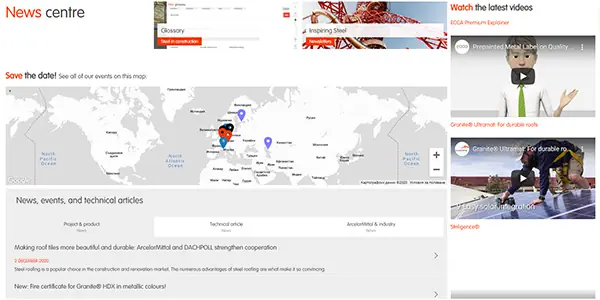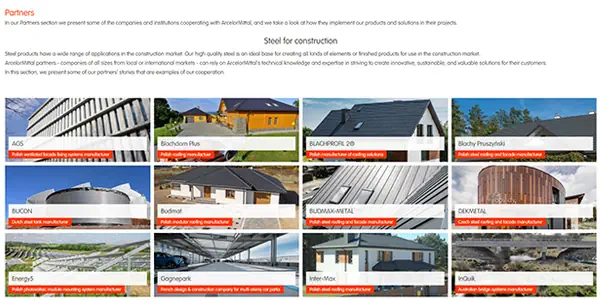About InQuik Bridging Systems
InQuik manufactures standardised, pre-certified, mass-produced bridges which can be easily transported anywhere in the world. The solution makes building a bridge quick, simple, low-risk, and cost-effective. InQuik employs 15 people in its sales and delivery team and produces systems at three factories in Australia. InQuik is currently preparing for expansion into the USA, Asia, and other regions around the globe.
More info: inquik.com.au
The T.C. Graham Prize
The T.C. Graham Prize has been awarded annually since 2014 to the winners of the Association for Iron & Steel Technology’s (AIST) annual design competition. The winning entry receives a 20 000 USD cash prize. The purpose of the contest is to encourage, generate, and incubate ideas that may lead to the development of new markets for steel.
More info: www.aist.org
Award-winning InQuik system uses Magnelis® to install innovative bridges quickly
Australian company InQuik has developed a unique method of building bridges which can be implemented quickly using only low-skilled labour. The globally patented technology utilises Magnelis® from ArcelorMittal Europe – Flat Products to create the formwork of a bridge, which is then filled with concrete to create the bridge deck. Although the bridges are designed for a service life of 100 years, experts believe that the use of Magnelis® could double that without the need for significant maintenance. With hundreds of thousands of bridges needing replacement around the world, the potential for the InQuik system is enormous. The innovative design of the InQuik system was recognised when it won the 2019 T.C. Graham Prize from the Association for Iron & Steel Technology (AIST).
The InQuik system
The InQuik system was developed by a family team including father and son Bruce and Logan Mullaney and Bruce’s brother-in-law, Jim Howell. Their original goal was to improve the systems used to transport modular housing with a collapsed container system. “When we went to register our idea of a reinforcement to hold the deadweight of concrete, the patent office told us this was completely new,” explains Logan Mullaney, now managing director of InQuik Bridging Systems. “We immediately started to think of other ways we could utilise this technology.”
With demand for bridges soaring globally, they seemed to be an ideal application notes Logan Mullaney: “We realised that by putting a truss in a reinforced steel shell we could hold the temporary load of the cement until it cured. Our first trial bridge was constructed on our own property in Australia. We built three in the first year and eight in the second year. This year, our third, we will install around 40 InQuik bridges.”
Magnelis® provides long-term strength
A key challenge was to identify a good material for the formwork which holds the concrete until it dries completely. “At first we thought about using galvanised steel, but over time this will rust and fall away,” says Logan Mullaney. “While the formwork is sacrificial, we realised that the sight of corroding metal would reduce user confidence in the bridge and increase the amount of maintenance required. We needed a more durable solution.”
InQuik was introduced to Magnelis® through a contact in Australia. “Magnelis® allows us to leave the formwork of the bridge in place as it has an aesthetically pleasing finish – and it is durable,” says Logan Mullaney.
Another key advantage of Magnelis® is the protection it offers to the concrete deck. “Because the formwork remains, the concrete and internal reinforcing steel are protected from corrosion,” explains Logan Mullaney. “That means the bridge will last longer. Engineers have estimated the useful life of an InQuik bridge could be well in excess of its 100-year design life, potentially up to 200 years.”
Confidence in quality
The Magnelis® formwork helps to contain plasticisers and water-soluble chemicals which occur in the concrete. Magnelis® ensures the preservation of natural resources as it uses significantly less zinc than pure zinc coatings. Zinc runoff is also reduced dramatically compared to galvanised steels.
“Magnelis® is not well known in Australia and we are one of the only companies utilising it,” notes Logan Mullaney. “But ‘Made in Europe’ is a quality label for Australian companies. Together with the fact that ArcelorMittal is the largest steelmaker in the world, this gives our customers – and bridge users – confidence in the system.”
Portable technology can be deployed globally
Magnelis® is imported into Australia from ArcelorMittal Bremen where it is produced. InQuik maintains a healthy stock in Australia as there is currently a four-month lead time on orders. “We’re looking how that lead time can be reduced so InQuik doesn’t have to maintain such a large stock of material,” notes John Robbins, export manager for ArcelorMittal Europe – Flat Products.
Compared to a conventional reinforced concrete bridge, the InQuik system is up to 90 percent more steel-intensive. However, the bridges are more cost-effective as they can be prefabricated and installation time is significantly lower explains Logan Mullaney: “InQuik bridges are standardised, pre-certified, and can be mass-produced. And it is possible to transport an entire bridge on one semi-trailer. You just back the truck up to the site, install the components, and then fill them with concrete. It only takes a small crane and a few days to build the bridge. Customers typically save between 20 and 50 percent compared to a conventional bridge due to the lower installation time and work, low risk, and less cranage.”
Text: ArcelorMittal Europe Communications
Images: InQuik Bridging Systems & AIST

































